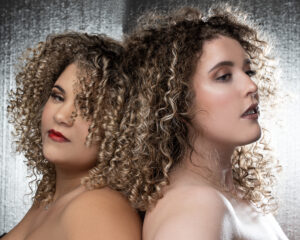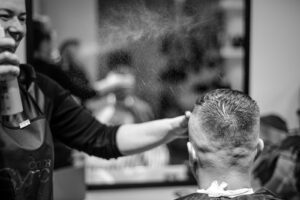Hair Care Fundamentals & Styling Guide
The Foundation of Great Hair Care
Learning hair care fundamentals is the foundation of every successful cosmetology career. Whether you’re just starting beauty school or refining your skills, understanding these core principles will set you apart as a professional stylist. These hair care fundamentals form the building blocks of every service you’ll provide throughout your career.

The Science of Hair: Structure and Composition
Your hair is primarily made of a protein called keratin. Each strand consists of three main parts:
- The Cuticle: This is the outermost layer, made of overlapping cells, which protects the inner layers. A smooth cuticle reflects light, making hair appear shiny.
- The Cortex: The middle layer that makes up most of the hair shaft. It contains melanin, which gives hair its color, and provides strength, elasticity, and texture to your hair. This layer determines whether your hair is straight, wavy, or curly.
- The Medulla: The innermost core, which isn’t present in all hair types.
Identifying Your Hair Type and Porosity
Knowing your hair type is crucial for selecting the right products and routines. Hair is generally categorized by:
- Texture: Straight, wavy, curly, or coily. Each texture has different needs for moisture and styling.
- Porosity: This refers to your hair’s ability to absorb and retain moisture.
- Low Porosity: Cuticles are tightly packed, making it harder for moisture to penetrate but also harder to escape.
- Medium Porosity: Cuticles are less tightly bound, allowing for good moisture absorption and retention.
- High Porosity: Cuticles are raised, absorbing moisture quickly but losing it just as fast.
Essential Hair Care Practices for Healthy Locks

Photo by abdullah ali on Unsplash
A consistent and appropriate hair care routine is the cornerstone of healthy hair. It doesn’t have to be complicated, but it does need to be effective.
The Art of Cleansing: Shampooing Right
Shampooing removes dirt, oil, and product buildup. The frequency depends on your hair type and lifestyle. Oily hair may need more frequent washing, while dry or curly hair might benefit from less frequent cleansing. Choose a shampoo formulated for your specific hair concerns.
Conditioning for Shine and Strength
Conditioner is vital for restoring moisture, detangling, and smoothing the hair’s cuticle after shampooing. Apply conditioner primarily to the mid-lengths and ends, allowing it to sit for a few minutes before rinsing thoroughly.
Gentle Drying Techniques to Prevent Damage
Aggressive drying can lead to breakage. Opt for gentle methods:
- Air Drying: The least damaging option.
- Microfiber Towel: Absorbs water quickly without roughing up the cuticle.
- Low-Heat Blow Drying: If you must blow dry, use a low heat setting and a nozzle to direct airflow.
Brushing and Combing: Tools and Techniques
Use the right tools for detangling. Start from the ends and gently work your way up to the roots to avoid pulling and breakage. A wide-tooth comb is excellent for wet hair, while a paddle brush or detangling brush works well for dry hair.
Mastering Basic Hair Styling Techniques
Styling can be fun, but protecting your hair is paramount.
The Golden Rule: Always Use Heat Protection
Before applying any heat (blow dryers, flat irons, curling irons), always use a heat protectant spray. This creates a barrier that minimizes damage from high temperatures.
Choosing the Right Styling Products
The right products can make a significant difference:
- Mousse: Adds volume and hold.
- Gel: Provides strong hold and definition.
- Serum: Adds shine and tames frizz.
- Hairspray: Sets your style in place. Choose products that complement your hair type and the style you want to achieve.
Fundamental Styles: Blowouts, Curls, and Straightening
Learning basic techniques for these popular styles will give you versatility. Practice makes perfect, and understanding how to use your tools correctly is key to achieving professional-looking results at home.
Beyond the Basics: Scalp Health and Common Concerns
Healthy hair starts with a healthy scalp.
The Importance of a Healthy Scalp
Your scalp is skin, and it needs care too. Regular, gentle cleansing and occasional scalp massages can improve circulation and create an optimal environment for hair growth. Issues like dryness, itchiness, or excessive oiliness often originate from the scalp.
Troubleshooting Common Hair Problems
Many common hair problems can be managed with the right approach:
- Dryness & Frizz: Focus on moisturizing products and gentle handling.
- Breakage: Minimize heat styling, chemical treatments, and aggressive brushing.
- Oily Scalp: Use clarifying shampoos and avoid over-stimulating the scalp.
Elevate Your Routine: When to Seek Professional Advice
While at-home care is essential, professional guidance can elevate your hair health.
The Role of a Cosmetologist in Hair Health
Cosmetologists are trained experts who can provide personalized advice on hair type, product recommendations, and advanced treatments. They can help you achieve specific styling goals, address persistent hair concerns, and ensure your hair remains in its best condition. Don’t hesitate to consult a professional for tailored solutions.


